60th Anniversary of Route 88 to Eyres Monsell
The first bus services to Eyres Monsell started on 18th January 1953 with routes 40 to Pasley Road/Lydall Road and 51 which continued on to Sturdee Road/Simmins Crescent. These both ran from Welford Place via Saffron Lane, but it was the date of 17th July 1960 that the Route number 88 was first introduced.
In a small way to celebrate the 60th anniversary here are some memories of the 88 service with photographs, timetable’s and other information relating to the last sixty years.
.
Sun 17 July 1960 : New Route 88
From : Welford Place, Newarke Street, Oxford Street, Aylestone Road, Saffron Lane, Glen Hills Boulevard, Pasley Road, Sturdee Road, Hillsborough Road, Monmouth Drive (Salkeld Road) RETURNING Monmouth Drive, Featherstone Drive, Hillsborough Road
Sun 31 March 1963
Moved to : Newarke Street bus station/York Road Bus Station (Stand 5)
Revised Inward Manoeuvre : Welford Road, York Road, Bus Station, Newarke Street

Sun 8 May 1966
Altered to run Inwards via Aylestone Road, Infirmary Road, Infirmary Square, Oxford Street, Newarke Street, Bus Station (new gyratory system)
Sat 28 December 1968 : Route 88
Moved from : Newarke Street bus station/York Road Bus Station to Bowling Green Street (middle barrier)
Sun 5 March 1972 :
Altered to run (Outwards) via : Welford Road, Almond Road, Aylestone Road (Granby Halls gyratory)
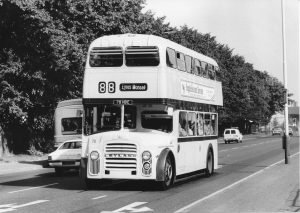
Sat 13 May 1972
Route 24 Saffron Lane Crossroads cancelled – replaced by additional 88 journeys
Sun 14 May 1972
Route 88 : Moved from : Bowling Green Street to Charles Street (Kildare Street)
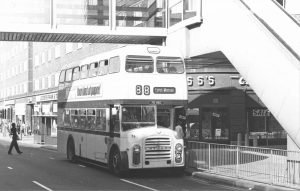
Mon 22 December 1974 : Route 88
Moved 50 feet further south along Charles Street (because of re-siting of pelican crossing)
By April 1982 : Route 88
Moved from : Charles Street to Humberstone Gate
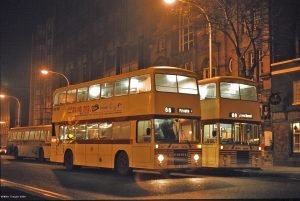
The 88 remained crew-operated until after it became the 38 Nether Hall – City Centre – Eyres Monsell under Leicester CityBus and was finally converted to one-man operation in the service changes on Sunday 29th September 1985.
Route Linkages
- from 14th May 1972 : 54 Stocking Farm – 88 Eyres Monsell
- from 9th September 1979 : 14 New Parks – 88 Eyres Monsell
- from 5th October 1980 : 41 Rushey Mead – 88 Eyres Monsell – 52 Braunstone Lane – 42 Melton Rd/43 Rushey Mead – 61 Nether Hall – 67 Evington – 41 Rushey Mead.
- from 18th April 1982 : 41 Rushey Mead – 88 Eyres Monsell – 42 Melton Road/43 Rushey Mead – 61 Nether Hall – 52 Braunstone Lane – 41 Rushey Mead.
- from 15th January 1984 : 41 Rushey Mead – 88 Eyres Monsell – 61 Nether Hall – 52 Braunstone Lane –41 Rushey Mead.
Route direction of the 88 on the Eyres Monsell.
When route 88 was extended to its present terminus at Salkeld Road turning circle, it initially ran in both directions to/from Hillsborough Road along Monmouth Drive. The current loop working, outward by continuing along Hillsborough Road then via Featherstone Drive and returning direct along Monmouth Drive, was introduced with the service changes on Sunday 9th September 1979.
When did the 88 become the 38? and back to route 88?
The 88 became the 38 in the changes introduced for the launch of Leicester CityBus on Sunday 7th October 1984. The 38 was Nether Hall – City Centre – Eyres Monsell, formed of former routes 61 Nether Hall and 88 Eyres Monsell. It then reverted to number 88 after the publicly advertised through working between Nether Hall and Eyres Monsell ended. The split was initially introduced on Mon-Sat main day only from Mon 29th Jan 2008 although at that time services on both sides of the City Centre retained the route number 38 and services actually continued to work through during evenings and on Sundays.

The Eyres Monsell section was renumbered 88 in the service changes from Sunday 2nd September 2007, when the 26 Mowmacre Hill – City – Saffron Cross Roads was split and the Saffron Cross Roads section was renumbered 88A. From the same date, the current Nether Hall – Thurnby Lodge loop working as 38 and 38A was introduced. However, even then most buses still worked through between routes 38/38A and 88/88A, changing route number in the City Centre, until the service changes of Sunday 8th May 2016 since when the 38/38A and 88/88A sections have been operated independently. The evening variant route 88E was introduced from Sunday 16th July 2017.

MORNINGS ON THE MONSELL
The 88 Eyres Monsell was a relatively new route when I first conducted it in late 1968. Saffron Lane itself, to the library, was familiar to me, on account of living then with my family on the estate for the previous three years, but no further than that. Indeed, the very first routes I ever conducted, in my first week on the road with an instructor, were the 23 and 24, both of which terminated at the cross roads. I heard stories right from the start of turns ‘on the Monsell’, how busy it was, and at times, how ‘lively’ it could be. But then, our new conductor’s heads were filled with canteen gossip about all of the city’s routes, just about every one of which had one sort of ogre or another to contend with.
My first impression on taking an 88 all the way to Monmouth Drive was how unbelievably long it was. It all seems very ordinary and regular now, but back then, we never ventured beyond the city boundary, and Monmouth Drive was very nearly on that boundary. I thought I would never learn all the stops, there seemed to be dozens of them. But in truth there was just another dozen or so after leaving Glenhills Boulevard, then an estate road along one edge of a very broad, green sward, to become part of the outer ring road after I left the city.
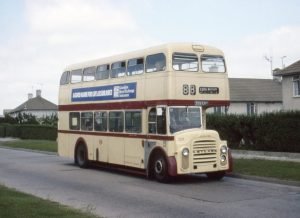
Within a few weeks, along with learning just about every other route in the city apart from the Outer Circle, by then one-man operated, I settled in to knowing my way around a little more. But like all the other routes, bus crews only got to know an estate, an area, on their immediate route. We learnt the names of side roads along the route, either because passengers asked for them by name, or they were named fare stage stops.
But in reality, learning any estate in the true meaning of the word is not possible unless you actually live there, or are part of it. I look at a map of the area now and see names of roads I’d never heard of before. So on the 88, Paisley, Sturdee, Hillsborough and Monmouth were all the names I ever did know, never having cause to venture further afield on either side of our route. So in five years, I never did get to ‘know’ the Monsell.
Earlies, middles and lates were the shifts, or turns, and I very soon got to work a broad range of times of the day on all three. I started in the latter months of the year, and was soon thrown into the oncoming winter. The first bus off the estate was 06.00 (??), and so it was still dark. Cold, wet, damp and foggy mornings come first to mind, working full buses by the time you got to Saffron Lane X Roads.
Indeed, we were frequently already full and leaving folks along the lower reaches of Paisley Rd. Then it would be a three bell load almost all the way to town, but dropping a few off and picking the same number up at the busiest stops along Saffron Lane as we went. The vast majority at that time would be going right into town, the early morning cleaners and factory hands of a typical industrial city, but you could easily lose almost half your bus load at Walnut St, and more again at the Royal Infirmary, testament to the numbers of hosiery, knitwear and boot manufacturers in the area, as well as many engineering works. And of course, a one or two nurses and hospital workers.
Picking up at perhaps the last stop on Paisley Rd, you’d whizz upstairs to collect fares just boarded. As your head rose above the level of the top step, your eyes would be greeted by the vision of the backs of over three-dozen cloth-capped heads, men of various ages, though you maybe couldn’t see the further than halfway down the bus clearly through the thick haze of grey cigarette smoke. Opening windows for fresh air seems to have been thought to be somewhat unsocial. As soon as one opened it, another would reach over and close it. Sometimes, I would open a window, perhaps the one near the top of the stairs. But it would be closed again before I went back up. Draughts were not allowed. But at that time, I was a smoker myself, so thought little of it.
The air would be so thick that there was no clear view of the top deck in the stair mirror, which itself could be running with condensation on very cold mornings. Ringing the bus off from the top of the stairs could be not a little problematic, the platform area barely discernable, and it was a regular thing to give the mirror a swift wipe with the sleeve my left arm on dashing back down to the platform.

There would be very little chatter, for although there were a few women and girl shopworkers, the majority would be men, of all ages from young apprentices to men nearing retirement, workmates often sitting together. As well as smokey, the air would be damp, with that earthy scent of damp raincoats and macs and dripping brolleys if a wet morning. So the windows would be dripping with condensation, as would the roof of the top deck itself.
I wore the LCT uniform cap, partly because we were expected to, partly for warmth, but it was also useful at keeping my hair dry. Being so tall, over 6ft, if I stood up straight, my hair would brush the roof and gain a tobacco-scented rain down my neck. A cap stopped all that, but I had to stoop when prowling the top deck collecting fares. The only thing that would be warm would be your ticket machine, issuing tickets so fast the friction almost made it seem to glow.
Such inbound morning journeys would be relatively swift, until the traffic built up. Speed was of the essence, and just about everyone was a regular, and knew exactly what they were doing. Loading a dozen passengers at one stop would be done in a jiffy, and all had their usual or favourite seat whether up or down. To spend more than 10 seconds at any one stop would be a long time. If only three or four men were to board, the wheels would barely stop at all, passengers jumping on as you moved down the queue. They would be quick, for they too wanted to get to work on time and not hold you up. When the last man had one foot on the platform, it was ding-ding and you were up the road in a flash. If a lady, at least we let her get both feet aboard. As for sitting down, some were still just gaining their seat when you arrived at the next stop.
From about 7am onwards, the first real hold-up would be getting out of the top of Saffron Lane, in the days before the traffic lights. Then there would be quite a queue for Walnut St lights, and from the Royal Infirmary onwards, a slow crawl up Oxford St and an ever slower one up the Newarkes. The last few hundred yards could take nearly as long as the rest of the route from the Monsell put together! So you would inevitably be late at the barrier, and barely spend more than 30 seconds there either, and it was away to go back and do it all over again.
I first knew the 88 as a ‘swinger’, not linked to anything else, and terminating in Bowling Green Street behind the Town Hall. At that time, the 87 Aylestone Rd route terminus to the Monsell was in York Rd. Later of course, the 88 was linked, to what I can’t recall, maybe 54, and started in Charles St just by the overhead walkway to The Haymarket. I think there were three barriers in Bowling Green St then, the first shared by the 24 and 25, then the 88, and in front, the 22 and 60 shared a barrier, both to Narborough Rd via the Royal and Jarrom St. The 24, 25 and 88 left alternately every few minutes, so maintaining something like a 10-minute frequency to Saffron Lane. By Gads, it were busy in those days.
Once the morning peak was over, the traffic died down somewhat, but the numbers of passengers didn’t. Again, you could be full to the brim with ladies going shopping, and after 9am, pensioners taking advantage of their half-fare concession. If ‘time’ were to be waited at Monmouth Drive terminus, you could easily have almost a full bus downstairs before you left, but this time there was no quietness to be had even with the engine stopped. Winter or summer, the air was full of cheerful chatter and occasional laughter, as friends old and new exchanged their latest gossip. You would frequently be full downstairs at least by the bottom of Paisley Rd, and indeed, you could barely hear yourself think for the noise or clearly hear the fares requested for the din.
An early turn that started with the first, or one of the first, buses from the Monsell would typically have four more journeys to complete after that first inward run before coming off for breakfast. The earliest duty on 88s would typically start at around 05.35. Ten minutes bus preparation time was all that was allowed and that might include being in a queue to top up with water. Then around a quarter of an hour for the run out, and that, remember, was from APR, and the only way then was straight through the town, Charles St, Belvoir St and so on to Aylestone Rd. No short-cut via St Margaret’s Meadows or the Underpass then. No time for hanging about. Actually, the quickest and most direct way was to go the 87 route to Hillsborough Rd, and at that time of the morning, you could easily keep up to 30mph (or more?) all the way to Wigston Lane lights.
If you did start with the earliest turns, you would be unlikely to get off for breakfast much before 11am. Five-and-a-half hours for the first part of a duty was commonplace at any time of day. Starting later, at say 7am or thereabouts would not see you off the road much before one-o-clock. That applied to all turns, on all routes, not just the 88.
Without doubt, easily the best bus for working this route and keeping to time would be a PD3A. Preferably one of the 46-55 or 66-75 series. For a conductor, they were generally warm, but a driver wouldn’t be bothered which PD3 we were allocated as all had cab heaters by then. A Bullnose PD3 could be just as fast, and I recall 166 as being something akin to a small rocket, and smokey too. But they were dim inside at night, and dark winter mornings, with individual 24v bulbs down each side. What could make them just a bit slower to work was their individual bell pushes inside each saloon, the favoured strip bell having not been introduced until the later deliveries of PD3As with their distinctive stylish bonnet, as per 16, 48 and 90.
What you most certainly did not want, but sometimes did get, was a Bridgemaster. If so, you would almost certainly be caned by virtue of running late, perhaps only by a few minutes. But that few minutes on the 88 would mean you were also picking up folks that had really come out for the next bus behind you. So you would easily get a three bell load that you were not meant to get, which of course, slowed you down even more. Additionally, being of lower height, and with a fussy internal step, they were also more crowded, folk took longer to both reach their seat and reach the platform when alighting. But then, a Bridgemaster on any really busy route was hard work, winter or summer.
The later Renowns were a great improvement, and warmer, and just about held their own against the average PD3. And we still had quite a few PD2s, and yes, occasionally got those on the Monsell too, but by my time they were not generally allocated to a ‘regular board’. They were more usually to be found on duplicates, showing 88 EXTRA, and then going on to a school service or similar. As to the three front-entrance Renowns; please sir, no! Please, do not give me a sweatbox, or I shall scream until I am sick !!
There was one bus that could be even worse news, and that was a Daimler. Large, spacious and airy inside, they were a pleasure to conduct in summer. But my word, they were so slow. But we only had five of them, and they only lasted another year or so after I started. They were not so bad on an 87, which seemed to have more time, was not so busy, and generally lighter loadings, mostly on account of there being less shops along the route.
Drivers of course, would nearly always prefer a one-legger, 16-35, if they could get one. They were good, but the manual clutch PD3s were sharper away from stops, and because of more efficient braking, could keep up a higher average speed. But of course, much harder work for the driver if a particularly heavy clutch was fitted.
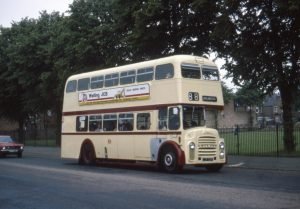
A PD3A/12 (the 12 designating the semi-automatic with the lighthouse tower gear change) could be, shall we say rather problematic, to stop quickly when fully loaded, and so slowing down had to be done rather sooner and with more advanced thought. I would not be the first one to have been caught out, having passed under the railway bridge on Saffron Lane almost at full pelt and fully loaded, outward bound at lunchtime, only to find that stopping at Hughendon Drive might take some time! Maybe forget that one and just go to Aylestone recce! LOL.
Having said that, I will never forget bus 21, both as a conductor and a driver. For some reason, it had a throatier exhaust, and could keep up with the best of them, a real goer. In my five years all told, I never knew 21 not to be a good bus. It was sad to hear that she had a really bad end.
Of course, we worked just as many late turns on the Monsell, and so ran the nightly gauntlet of the several well-known and popular pubs and working mens’ clubs along the route. At weekends, sometimes with the assistance of the local constabulary. But maybe that is for another time when I can control the shakes better that such memories engender! LOL again!
Rob Haywood
Thank you to Mike Tongue, Chris Jinks, Mike Greenwood, Peter Newland, Trevor Follows and Rob Haywood for information and photos.


A fascinating read! I lived on Eyres Monsell from around 1957 onwards and one of my earliest memories is catching the bus home from Welford Place terminus.
Were the Eyres Monsell services joint with Midland Red from the start? And did Midland Red buses show the same route numbers (but with an ‘L’ prefix?) As a young child I seem to remember someone talking about the L51 I clearly remember the services becoming 87/L87 and 88/L88